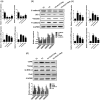Diallyl trisulfide inhibited tobacco smoke-mediated bladder EMT and cancer stem cell marker expression via the NF-κB pathway in vivo
- PMID: 33730908
- PMCID: PMC8166398
- DOI: 10.1177/0300060521992900
Diallyl trisulfide inhibited tobacco smoke-mediated bladder EMT and cancer stem cell marker expression via the NF-κB pathway in vivo
Abstract
Objective: This study examined the effect of the NF-κB pathway on tobacco smoke-elicited bladder epithelial-mesenchymal transition (EMT) and cancer stem cell (CSC) marker expression in vivo. The effect of diallyl trisulfide (DATS) treatment was also examined.
Methods: BALB/c mice were exposed to tobacco smoke and treated with an NF-κB inhibitor and DATS. Western blotting, quantitative real-time PCR, and immunohistochemical staining were used to detect the changes of relevant indices.
Results: Phosphorylated inhibitor of kappa-B kinase alpha/beta expression and p65 and p50 nuclear transcription were increased by tobacco smoke exposure, whereas inhibitor of kappa-B expression was decreased. In addition, tobacco smoke reduced the expression of epithelial markers but increased that of mesenchymal and CSC markers. Our study further demonstrated that tobacco smoke-mediated EMT and CSC marker expression were attenuated by inhibition of the NF-κB pathway. Moreover, DATS reversed tobacco smoke-induced NF-κB pathway activation, EMT, and the acquisition of CSC properties in bladder tissues.
Conclusions: These data suggested that the NF-κB pathway regulated tobacco smoke-induced bladder EMT, CSC marker expression, and the protective effects of DATS.
Keywords: IKKα/β; IκB; NF-κB; Tobacco smoke; bladder cancer; cancer stem cells; diallyl trisulfide; epithelial–mesenchymal transition.
Conflict of interest statement
Figures






Similar articles
-
Diallyl trisufide (DATS) suppresses high glucose-induced cardiomyocyte apoptosis by inhibiting JNK/NFκB signaling via attenuating ROS generation.Int J Cardiol. 2013 Sep 20;168(1):270-80. doi: 10.1016/j.ijcard.2012.09.080. Epub 2012 Nov 13. Int J Cardiol. 2013. PMID: 23158927
-
Wnt/β-catenin modulates chronic tobacco smoke exposure-induced acquisition of pulmonary cancer stem cell properties and diallyl trisulfide intervention.Toxicol Lett. 2018 Jul;291:70-76. doi: 10.1016/j.toxlet.2018.04.003. Epub 2018 Apr 4. Toxicol Lett. 2018. PMID: 29626521
-
Diallyl trisulfide induces pyroptosis and impairs lung CSC-like properties by activating the ROS/Caspase 1 signaling pathway.Chem Biol Interact. 2024 Jul 1;397:111083. doi: 10.1016/j.cbi.2024.111083. Epub 2024 May 30. Chem Biol Interact. 2024. PMID: 38821455
-
Epigenetic Upregulation of Metallothionein 2A by Diallyl Trisulfide Enhances Chemosensitivity of Human Gastric Cancer Cells to Docetaxel Through Attenuating NF-κB Activation.Antioxid Redox Signal. 2016 May 20;24(15):839-54. doi: 10.1089/ars.2014.6128. Epub 2016 Mar 30. Antioxid Redox Signal. 2016. PMID: 26801633 Free PMC article.
-
Disulfiram inhibits TGF-β-induced epithelial-mesenchymal transition and stem-like features in breast cancer via ERK/NF-κB/Snail pathway.Oncotarget. 2015 Dec 1;6(38):40907-19. doi: 10.18632/oncotarget.5723. Oncotarget. 2015. PMID: 26517513 Free PMC article.
Cited by
-
Targeting Cancer Stem Cells by Dietary Agents: An Important Therapeutic Strategy against Human Malignancies.Int J Mol Sci. 2021 Oct 28;22(21):11669. doi: 10.3390/ijms222111669. Int J Mol Sci. 2021. PMID: 34769099 Free PMC article. Review.
-
Diallyl Trisulfide Enhances Doxorubicin Chemosensitivity by Inhibiting the Warburg Effect and Inducing Apoptosis in Breast Cancer Cells.J Cancer. 2025 Jul 11;16(11):3283-3295. doi: 10.7150/jca.113578. eCollection 2025. J Cancer. 2025. PMID: 40861817 Free PMC article.
-
Palmitic Acid Promotes Lung Metastasis of Melanomas via the TLR4/TRIF-Peli1-pNF-κB Pathway.Metabolites. 2022 Nov 17;12(11):1132. doi: 10.3390/metabo12111132. Metabolites. 2022. PMID: 36422271 Free PMC article.
-
Diallyl trisulfide inhibits osteosarcoma 143B cell migration, invasion and EMT by inducing autophagy.Heliyon. 2024 Feb 22;10(5):e26681. doi: 10.1016/j.heliyon.2024.e26681. eCollection 2024 Mar 15. Heliyon. 2024. PMID: 38434350 Free PMC article.
-
Skullcapflavone II suppresses TGF-β-induced corneal epithelial mesenchymal transition in vitro.Int J Ophthalmol. 2025 Feb 18;18(2):209-215. doi: 10.18240/ijo.2025.02.02. eCollection 2025. Int J Ophthalmol. 2025. PMID: 39967985 Free PMC article.
References
-
- Antoni S, Ferlay J, Soerjomataram I, et al.. Bladder Cancer Incidence and Mortality: A Global Overview and Recent Trends. Eur Urol 2017; 71: 96–108. - PubMed
-
- Alifrangis C, McGovern U, Freeman A, et al.. Molecular and histopathology directed therapy for advanced bladder cancer. Nat Rev Urol 2019; 16: 465–483. - PubMed
MeSH terms
Substances
LinkOut - more resources
Full Text Sources
Other Literature Sources
Medical
Research Materials

